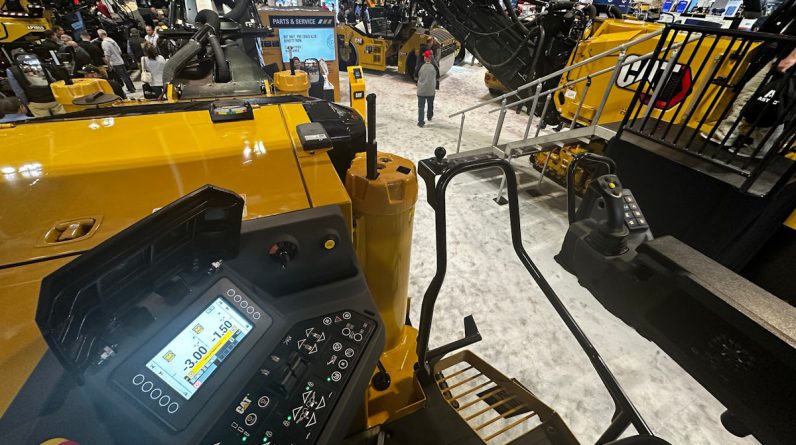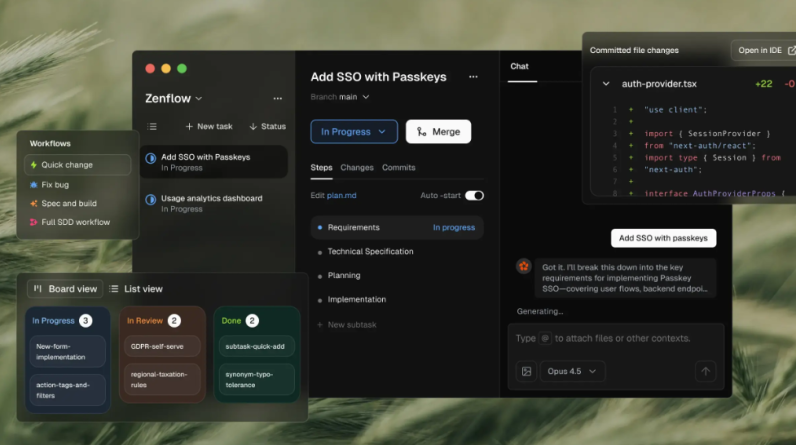
I went to World of Asphalt 2024 knowing there would be a lot of new technology on display, but what I found was a surprising reality of just how advanced the tools of our trade have become. Data capture and telematics give us all the pieces of the jobsite puzzle. How long before a system can put them all together better than human operators? With the power of new algorithms and, not to mention, the creeping presence of artificial intelligence, the answer might be, “Sooner than you think.”
The Ever Present Now: Paving
The rate of technological change and advancement is mind bending, even in just the two years since I came into this industry, I’ve seen rapid evolutions in precision and power. Before exploring what the future might hold, there are plenty of exciting and useful products that are helping contractors today get the job done.
“We have for quite some time, been trying to figure out how we can help reduce some of the mental fatigue of the job while at the same time improving the pavement,” said Tom Travers, director of technical sales, talking about Astec’s newly revealed SmartEdge joint matching screed.
“That’s what drove the development of this sensor. If we just think of conventional paving, the work of closing a joint, the daily job description of a screed operator is to watch that joint, and don’t take their eyes off of it. They have to bump the extension in-and-out as the paver moves so that we get good closure. The problem is, if they do their job well, almost all of their focus is matching that joint, and they might lose focus on other important things going on.”
Along with material delivery, conveyor speed, auger speed, and other best practices that determine the behind the screed quality is as high as it can be, it’s easy to see the benefit of the SmartEdge tech relieving one of the most active and intensive demands off of the operator. Flatness, smoothness and density critical pay-items, and in the wake of something like this type of system, the crew can stay on top of those factors with much more consistency and accuracy.
But there have been previous iterations of similar products that didn’t quite live up to the hype. The challenges a sensor like this faces in the paving environment include a lot of particulates, smoke, dust, high waves of heat, and vibrations. Astec says that it put SmartEdge through all the paces.
“We have been prototyping this device all over the country in different situations, different materials,” Travers said. “It’s been strongly vetted along with our prototyping of the new F platform. And it does only live with the F-tractor, it can’t go backwards into our older machines or retrofitted.”
He explained that since the SmartEdge is fully integrated into the machine’s systems, like the hydraulic controls, and since the paving platform and the SmartEdge were prototyped together, it’s truly a next-generation technology. While it’s not usable as a standalone device, what does this level of integration get you on the jobsite?
“First, you select the edge, it could be a milled joint, a concrete curb, a gutter, a barrier wall, or it could be anything,” Travers explained. You give it some parameters, from zero to about fourteen inches and it monitors that edge. That information goes back into the tractor and it tells the extension where to live. It can hold that and hold it at an extremely high tolerance. Not in centimeters, not in inches, but finer than a human could manage.”
Getting Beneath The Surface: Milling
Milling technology and mills in general were all over the trade show floor at World of Asphalt. Anyone and everyone was highlighting their new offerings. At a press event in the Wirtgen booth, Tom Chastain, milling product manager for the company, discussed the North American debut of the new F-Series, highlighting its capabilities, including increased horsepower, versatility, and precision job data calculation.
He emphasized the importance of utilizing the machine’s advanced features, such as the Performance Tracker, to optimize job performance and profitability. “Performance Tracker it is a GPS base, there’s a laser on machine,” Chastain said. “With it, you can gather all sorts of useful data, whether you’re making a full pass, half pass, or whatever the case may be. At the end of the day, you can close out that job and know square yards, cubic yards, square feet, fuel, water, and even cutting tool consumptions. You can even see how many tons loaded in each one of the trucks that day, as well as, idle time.”
Additionally, paired with the Wirtgen operations center, you can see live performance data in real time on a mobile device like a smart phone or tablet. Companies like Trimble and Topcon have also updated their software and hardware modules, which can be fitted to numerous machines and is similarly accessible through familiar mobile technology platforms.
“What [Trimble] Roadworks does, is it migrates to the to the newer platform… you can be running B2W software and machine control software at the same time,” said Kevin Garcia, General Manager, Civil Specialty Solutions. “If I’m standing on the mill, and one of my jobs is to track the number of trucks that are hauling millings away, I can keep an idea of how many tons we’ve milled out. I’m using my machine control screen to manage the up-down-left-right of the mill, where I’m changing the profile or I’m optimizing the profile of the road for smoothness, material management, quality, QC type stuff. At the same time, I can just swipe right, and now I’m in my B2W track window.”
The Roadworks 3D milling capabilities provide contractors extraordinary tools to fix problem areas on a road from a subsurface level. “You can create your model, push it through Works Manager out into the field, it shows up on the [mill],” said Garcia. “You’re always on the latest model, because you’re on a connected site. You can query the cloud, you can pull back the digital as-built data into the office. You can say, ‘Here’s what we said we were going to build, and here’s what we did build, and how closely those two things aligned.”’
The ability to capture and compare worksite data is an ever growing want in the construction space, as it provides not only actionable and billable information, but, also, educational items that can be learned from.
“That is a big piece of what the construction market wants today,” said Mark Larranaga, director of intelligent paving business development at Topcon. “This is particularly true in the payment. Not only do they want to have the data from what they were going to construct, they also want to have the data from what actually is constructed. Then they can compare those bits and pieces of information, and make sure that they got the job done correctly.
The new Topcon MC-X3 is a more compact and powerful “brain” than its predecessors and it comes with features beyond just data capture. Like the Trimble Roadworks, it can allow for 3D milling procedures to take out imperfections in a surface, by getting down beneath years of old mill-and-fills. It can also implement what Larranaga called the, “virtual ski.”
“It’s doing variable depth milling so that you get down to a flat surface instead of leaving bumps and dips,” Larranage explained. “If I’m not using 3D, and I’m running skis on a mill, I have to have a physical ski out there with sensors actually feeling it, and that’s what’s given us our smoothness. In some cases and conditions like bridges, or curves, that ski might not actually be useful. Now, we can use a virtual-ski, using a digital file instead of a physical ski.”
Future Frequency: Compaction
There’s also no shortage of technological advantages in the realm of compaction, both for dirt and asphalt. BOMAG has BOMAP Connect, a subscription-based cloud solution that interfaces with an Android tablet or smart phone, which can track number of passes, soil compaction, material stiffness, and any other set jobsite parameters. While some other companies like Dynapac have launched new technological advances built into the roller drum itself.
The SEISMIC technology was first rolled out for Dynapac’s soil division, but at WOA 2024 they were making a strong push for the technology’s applicability on asphalt surfaces.
“There’s a natural resonance frequency of every surface that you’re compacting,” said Eric Booth, Dynapac’s compaction production manager. “What you’re doing is matching that frequency with the drum to get a more optimal compaction. Traditionally, what double drum rollers do is turn to a low amplitude, and a high vibration. That hits the asphalt hard. If you ever see a chalk-like color on your mat, it’s shattering the rock. That reduces how dense your road is going to be.”
The SEISMIC system uses special sensors combined with a smart computer system to find the best frequency to set the vibration and oscillation, in order to, not only prevent over compaction, but to reduce wear-and-tear, improve operator ride experience, and get the best possible density. That’s especially good news for those jobs where measured density is a payable item.
Caterpillar has similarly gone all-in on putting more technology in its lineup of rollers, the CB-10, 8, and 7, greatly expanding their versatility and features.
“One of the new features is a split drum,” said Cary Bryant, senior service engineer at Caterpillar. “The front and rear drums are both split in the middle. It works like the differential in a car. When you make a tight turn, the outside of the drum can turn a little faster than the inside of the drum. That allows the drum to go around a tight turning radius and not tear the asphalt mat.”
However, there are some cases where tearing or cutting the mat is what you need to do. On certain density critical jobs, like airports, the required density must go all the way edge-to-edge. In those situations where there are unconfined edges, the material has a tendency to be squeezed outwards as you reach those zones. To correct for this, it usually requires a cutter, and Caterpillar now has those as options for these split drum rollers.
“The edge cutter is a more economical way to remove that material than to have an individual saw cut a mile and a half,” said Bryant, but there are other options, too. “Instead of cutting or moving you can compact and constrain. If you think about that same unconfined edge, instead of a cutting wheel, when we’re first compacting that mat, it uses a wheel with a 45 degree bevel to it. It prevents the material from smashing out, and it puts a nice, clean angle on the edge of the mat.”
…And Beyond!
The amount of technology coming standard on new machinery is impressive, and so are the after-market modules that can be fitted to almost any machine on the jobsite. Where is all the headed? This leads back to the first question we asked in this article. Speaking strictly off-the-record at World of Asphalt, more than one person told me that true machine automation is a lot closer than it may currently seem. This included talk about automated mills and pavers, operating on pre-built models.
The leap from “operator assist” to “assisting operator” aren’t that far apart, and would flip the current script where the technology guides our human workers, to a jobsite that has the human element present to guide and aid automated machinery. As has been said many times before, the human element will never be fully removed, but a change in roles is definitely on the horizon.






